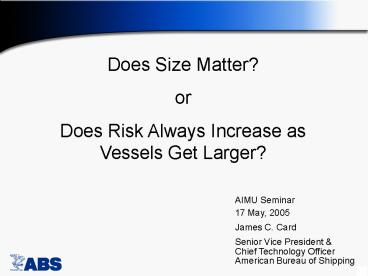Does Size Matter? - PowerPoint PPT Presentation
1 / 24
Title:
Does Size Matter?
Description:
Does Size Matter? or Does Risk Always Increase as Vessels Get Larger? AIMU Seminar 17 May, 2005 James C. Card Senior Vice President & Chief Technology Officer – PowerPoint PPT presentation
Number of Views:86
Avg rating:3.0/5.0
Title: Does Size Matter?
1
Does Size Matter? or Does Risk Always Increase
as Vessels Get Larger?
AIMU Seminar 17 May, 2005
James C. Card Senior Vice President Chief
Technology OfficerAmerican Bureau of Shipping
2
Outline of Presentation
- History of Vessel Size Increase
- Fundamentals of Marine Risk
- ABS Risk Management Capabilities
- Managing Container Carrier Risk
- Managing LNG Carrier Risk
- Managing FPSO Risk
- Summary
3
Maximum Ship Size by Year of Build
4
Goal is to Prevent Accidents
5
Risk Understanding
Risk fn(Frequency, Consequence)
How likelyis it?
What cango wrong?
What arethe impacts?
Loss Scenario (e.g., fire, collision, loss of
cargo, etc.)
Consequence (e.g., 1MM cargo lost, 3 crew
fatalities, etc.)
Frequency (e.g., 1 in 1000 voyages, 1 in 100
years, etc.)
6
What is the Impact of Increased Size on Loss
Scenarios?
- Larger vessels may introduce hazards or failure
modes not present in standard size designs. - Past experience, though useful, will not predict
a complete set of undesirable events. - Thus,
- Consideration of unwanted events, consequences,
failure modes and mechanisms is an integral part
of successful design
7
What is the Impact of Increased Size on
Consequences?
- Usually more severe (i.e. more cargo lost, more
crew and passengers exposed, higher property
value, higher cost per day of vessel
unavailability) - Usually, impact may be estimated by extrapolation
8
What is the Impact of Increased Size on
Likelihood?
- May require significant analysis to determine
impact - Reduced exposure (e.g., fewer vessels, fewer
trips) may mean reduced likelihood of loss
accidents - Factors such as increased stopping distance,
reduced visibility, maneuverability, etc. may
mean increased likelihood of loss accidents - Likelihood is usually the part of the risk
equation most easily addressed by implementing
design or other control features, thus reducing
overall risk
9
What is the impact of Increased Size on Risk?
Risk fn (Consequence, Frequency)
Consequence
Frequency
Size
Size
Risk
Size
10
ABS Guide for Review and Approval of Novel
Concepts
- No established Class Rules for Novel Concepts
- Pushing the boundaries of size fits ABS
definition of novel concept - Guidance Notes on Review and Approval of Novel
Concepts - Engineering
- Testing
- Risk Assessment
- Acceptable level of safety in
- line with current practice
11
MegaVessels can Achieve Safety Levels Equivalent
to that of Average Vessels
HighRisk
Casualty of average size vessel
Medium Risk
Increasing Event Likelihood
Casualty of mega size vessel
Low Risk
Increasing Event Severity
12
ABS Guide for Review and Approval of Novel
Concepts
- Build a body of evidence to address approval of
novel features - Design Assessment Plan
- Aspects for which there are codes / standards
- Aspects, which due to their novelty, require a
more rigorous approach - Risk Assessment Plan
- HAZID, FMEA, HAZOP, What-If, etc.
- Input to engineering design
- Identify need for proof / modeling / data
gathering / refined risk assessment
13
Adequate Design Risk Management Eliminates Many
Problems
14
Where Are We Now?
- Consideration of unwanted events, consequences,
failure modes and mechanisms is an integral part
of successful design - ABS application of risk management principles for
large ships - Container Carriers
- LNG Carriers
- FPSOs
15
Concerns with Larger Ships
- Challenges when we push our boundary beyond the
norm - Limited relevant engineering and service
experience - Uncertainties associated with extrapolation from
smaller ships - Unexpected issues associated with innovation
- Challenges in engineering
- Design
- Prediction of loads, strength, acceptance
criteria - Visibility
- Maneuverability
- Powering
16
Concerns with Large Containerships
- Evolving Features
- Greater capacity
- Higher power
- Increased flare
- Structural flexibility
17
Risk Management for Containerships
- ABS Capabilities
- Whipping
- Parametric roll
- Vibration
- Lashings
- Shaft alignment
18
ABS Risk Management for-LNG
ABS Technology for LNG covers the Gas
Transportation Chain
Propulsion Vibration
HullMaintenance
Dual Fuel
Containment System Integrity
Collision and Grounding
Terminal Class/Certification
Structural Integrity
Ice Strengthening and Cold Weather Operations
19
ABS Risk Management for -LNG
- Most critical aspect of most modern large LNG
tankers is sloshing in partially filled cargo
tanks - ABS developing breakthrough technology in
Membrane Containment System Design - Simulation
and experimental testing leading to more
operational flexibility without
compromising safety integrity
- Technology activity will lead to another industry
first - Guide for Strength Assessment of LNG
Containment Systems
20
Simulation of LNG Carrier Collision
21
FPSO - Ship or offshore structure?
22
ABS Risk Management for FPSO
Conversions of existing single hull tankers to
FPSOs - unique concerns
- Remaining structural life
- Strength to accommodate new features
- Oil processing system hazards
23
ABS Risk Management for FPSO
Purpose built FPSOs present new challenges
- Shift design criteria to offshore philosophy
- Risk based inspection
- Complex production systems
24
Summary
- Risks in marine transportation and offshore
operations can be identified and managed - ABS addresses systematically risk in new marine
concepts including much larger vessels
Its not the size of the ship that determines the
risk to safety, but the size of the risk that
determines the safety of the ship
Its not the size of the dog in the fight, its
the size of the fight in the dog































